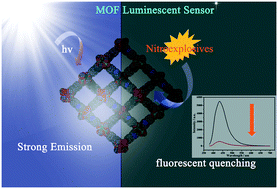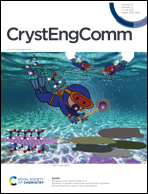A luminescent metal–organic framework with tetragonal nanochannels as an efficient chemosensor for nitroaromatic explosives detection†
Abstract
A novel 3D MOF [(Zn4O)(H2O)2(TPA)2]·8DMA (1) (H3TPA = 4,4′,4′′-nitrilotrisbenzoic acid; DMA = N,N-dimethylacetamide) with tetragonal nanochannels has been rationally obtained under solvothermal conditions using the fluorescent ligand H3TPA. MOF 1 demonstrates a unique (3,6)-connected network with nanosized square channels, displaying strong blue emission. Interestingly, 1 can be used as a fluorescent probe, which can detect nitroaromatic explosives efficiently and selectively via fluorescence quenching phenomena. As the number of –NO2 groups increase, fluorescence quenching becomes more obvious, which is maybe because the energy transfer from the electron-donating framework to electron-withdrawing nitroaromatic analytes becomes greater. Notably, the sensor is particularly sensitive to picric acid (PA), showing complete fluorescence quenching at a PA concentration as low as 30 ppm. MOF 1 can be recycled in the detection of nitroaromatic explosives with excellent recyclability. Additionally, the photo-induced electron transfer mechanism was validated through theoretical calculations for the fluorescence quenching.

- This article is part of the themed collection: Crystal Growth


 Please wait while we load your content...
Please wait while we load your content...